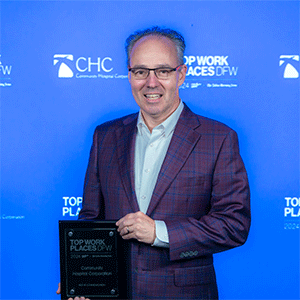After decades in the hospital industry, one thing is certain: Jim Kendrick, president/CEO of Community Hospital Corporation (CHC), knows the weight of a hospital’s success — or failure.
For Kendrick, who built a career helping hospitals regain and maintain financial and operational stability, his board chairmanship presents an opportunity to do the same for the entire industry amid the highly anticipated 2025 legislative session.
On Jan. 14, 2025, the 89th Texas Legislature will gavel in — the first and last certainty for the next 140 days. From there, the hospital industry is waiting to see how lawmakers will attack, or defend, their ability to care for communities.
Fortunately, preserving health care access is at the heart of Kendrick’s work.
“Health care is about people. Whether you’re saving a hospital or advocating for funding, it all comes back to ensuring the best care for the communities we serve,” Kendrick explains.
Over the past year as THA’s board chair-elect, Kendrick worked with THA’s President/CEO, John Hawkins and the 2024 board chair, Brad Holland, to prepare THA and hospital CEOs for the next session.
“I think it will be invaluable to have someone like Jim, who has an exceptional ability to turn challenges into opportunities, as our board chair during a session year,” says Hawkins. “From rural community hospitals to urban systems, Jim’s experience spans the spectrum of health care delivery, and we’re fortunate to have a leader like him aligned with our advocacy work.”
Early Life and Inspirations
Health care runs in the Kendrick family.
The son of a nurse and a hospital CFO, Kendrick felt an almost immediate calling to the profession. In ninth grade, Kendrick sat down with a hospital CEO who explained what the career path of a health care administrator looked like and entailed.
“That discussion in high school opened my eyes to how much of a difference you could make, not just in the clinical setting, but in ensuring hospitals have resources to serve their communities effectively.”
From that fortuitous meeting, Kendrick was singularly focused on a career in health care administration. Even his college job as a “jump master” at a bungee jumping company helped inform his leadership style, teaching others that reward waits on the other side of risk.
“As a jump master, my job was convincing people to take that leap, to push past their fear and trust the process,” Kendrick recalls. “Almost everyone who got to the edge had second thoughts. My role was to guide them through the fear and assure them it was safe — and that the experience would be worth it.”
After college, Kendrick received his master’s degree in health care administration at Trinity University, then his residency at Hillcrest Hospital in Tulsa, Oklahoma, which he later returned to before the hospital sold. From there, his path was paved by diverse experiences, including managing for-profit and not-for-profit hospitals, opening new facilities, reviving struggling hospitals and making the difficult decision to close or sell hospitals when necessary.
Unlike other industries, Kendrick knows what’s done on the balance sheet impacts what happens, or doesn’t, at the bedside. He speaks passionately about the role of hospitals in their communities, not just as providers of care.
“When someone’s loved one is in their most vulnerable moment, they need to know their hospital will be there for them,” he says.

Kendrick at THA’s headquarters in Austin, Texas.
Reflecting on the breadth of his career, Kendrick says, “I’ve opened hospitals, closed hospitals, and helped turn them around. Each of those experiences has been meaningful in its own way because the goal is always the same: to ensure access to quality care for the people who depend on us.”
This commitment extends to his own family, many of whom have followed him into the health care field. Two of Kendrick’s children are pursuing careers in health care administration, while another pursued a clinical profession and works as a nurse.
The Bigger Picture
Jim is currently the president and CEO of CHC, a non-profit health care organization based in Plano, Texas, with a mission to help hospitals remain community-operated and governed. Consulting over 100 hospitals across 26 states, CHC’s extensive reach underscores its commitment to preserving and enhancing community hospitals’ sustainability.

Kendrick holding CHC’s 2024 Top Workplace award from Dallas Morning News.
CHC offers a comprehensive suite of services, including hospital ownership, management and consulting to enhance the performance and sustainability of community hospitals.
Kendrick’s leadership at CHC spans nearly eight years, twice the average tenure of a hospital CEO. He credits the organization’s wide-reaching impact as a driver of his professional fulfillment.
“Coming to lead CHC, it’s a mission-driven, gratifying business. We’re not there to make a margin. We don’t enter a potential relationship asking, ‘Will this make us money?’ We look at whether we can help turn things around, stabilize the situation, and maintain care in the community.”
Unlike a typical hospital CEO, whose focus is usually contained to one facility, its staff, operations and community, Kendrick’s role at CHC requires him to work with many hospitals across diverse markets, each with unique challenges and needs. This vantage point allows Kendrick and his team to see the bigger picture and easily spot recurring themes across all states, markets and hospital types. Specifically, this includes the growing significance of supplemental payments and Medicaid funding for community hospitals.
“The complexity of Medicaid funding and supplemental payment programs continues to be a major hurdle. These payments are vital for hospitals, especially in a state like Texas that hasn’t expanded Medicaid, but the models are constantly changing, creating uncertainty.”
Supplemental payments and Medicaid funding are critical for community hospitals. Because Medicaid payments do not cover the actual cost of care, supplemental funding, like Medicaid Disproportionate Share (DSH) hospital payments, partially offset the financial loss for hospitals that care for a high volume of Medicaid or uninsured patients. Unfortunately, Medicaid DSH payments are routinely cut, despite the increasing number of uninsured patients in Texas.
Kendrick says that, for many hospitals, supplemental payments are a “lifeline” protecting hospitals from becoming overwhelmed by the financial strain of uncompensated care, which is then shifted to employers. He believes it is up to hospital executives and organizations like THA to educate lawmakers, the public and other stakeholders, such as local business leaders, about why sustainable funding for hospitals is non-negotiable.
“Too often, hospitals are seen as a financial burden, especially by businesses managing rising insurance premiums,” Kendrick explains. “What we need is alignment — helping businesses understand that when Medicare and Medicaid don’t cover the cost of care, those expenses inevitably shift to private payors.”
Facing the Future
If 2021 was the session year where hospitals were glorified as heroes that made recovery from the pandemic possible, then 2023 was the year they were maligned as scapegoats, blamed for rising health care costs.
Fortified with new alarming statistics from a 2022 Kaufman Hall report showing that almost one out of every 10 Texas hospitals were at risk of closure, hospital advocates looked forward to the 2023 session as an opportunity to rebuild from the fallout from the pandemic.

Kendrick with members of THA’s lobby, policy and communications teams.
Instead, hospitals spent most of the 2023 session fending off bad bills that threatened access to care. Examples included a proposed ban on hospital outpatient payments, a proposal to institute government rate-setting and a proposal to appoint a committee of lawmakers to set a maximum payment rate for four state employee health plans.
In response, THA rallied hospital CEOs together to participate in a year-long effort to educate lawmakers and the public on what drives up the cost of health care delivery. The widespread participation from Texas hospitals heartened Kendrick, who says the first step of turnarounds is recognition that a turnaround is necessary.
“The first step in turning around a hospital is helping the leadership and board recognize the urgency of the situation. Without that acknowledgment, it’s impossible to make the tough decisions required to stabilize and improve performance.”
He added that every hospital turnaround teaches the same lesson: “Success depends on leadership that’s willing to make hard decisions while staying focused on the mission of providing care.”
Kendrick’s approach to leadership has always been rooted in collaboration. Whether working with boards, staff, or local governments, he emphasizes the importance of aligning everyone’s interests for the greater good. It’s a vision that is also shared by THA’s new Advocacy leadership.
“We’re prepared to harness the hard-learned lessons of the 2023 legislative session into an even more offensive approach for 2025,” says Carrie Kroll, senior vice president of Advocacy and Public Policy at THA. “Jim Kendrick’s track record of uniting diverse stakeholders will be critical as we bridge divides, tackle unresolved challenges and focus on new priorities in the legislative session ahead.”
As he takes the helm of THA, Kendrick’s vision is clear: a sustainable, equitable health care system that serves every Texan. A future that’s only possible with a robust health care infrastructure that’s adequately supported, both financially and morally.
“Health care is a team effort,” he says. “From the doctors and nurses to the housekeepers and administrators, everyone plays a role. And my job is to make sure they have the resources they need to succeed.”
Related articles from The Scope
2025 Newsmakers in Texas Hospitals
Sponsored by Envision Healthcare, THA’s Newsmakers are hospital executives and…
THA’s 2025 Session in Review: Outcomes for Texas Hospitals
Medicaid talks in Washington, D.C., measles in West Texas and…
Accepting Nominations for THA’s Boards, Councils and Committees
Now through July 3, members can nominate Texas hospital leaders…
National Hospital Week 2025: Appreciation and Awareness
National Hospital Week is a time to celebrate health care…
Women to Know in Texas Hospitals, Health Care and Public Policy
The 89th Texas Legislature is underway and there are a…
Nomination Period Now Open for Texas Hospital Awards
Every year, the Texas Hospital Association recognizes the outstanding contributions…






